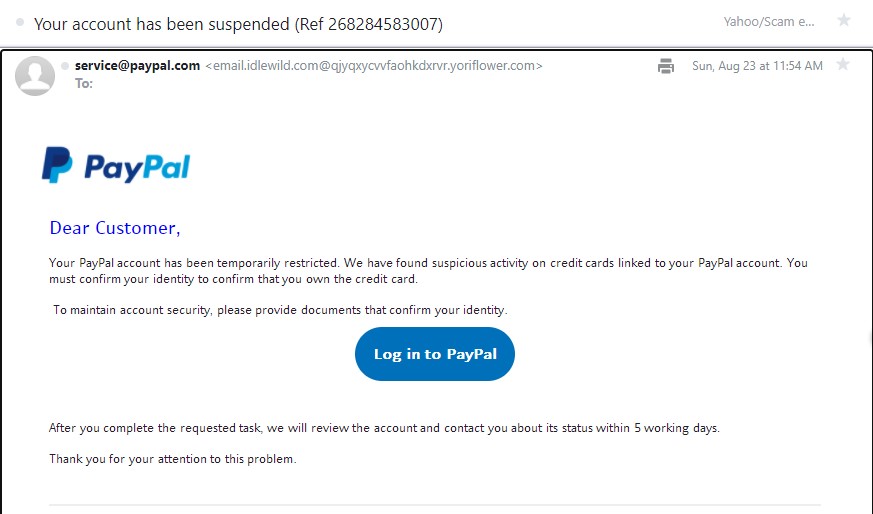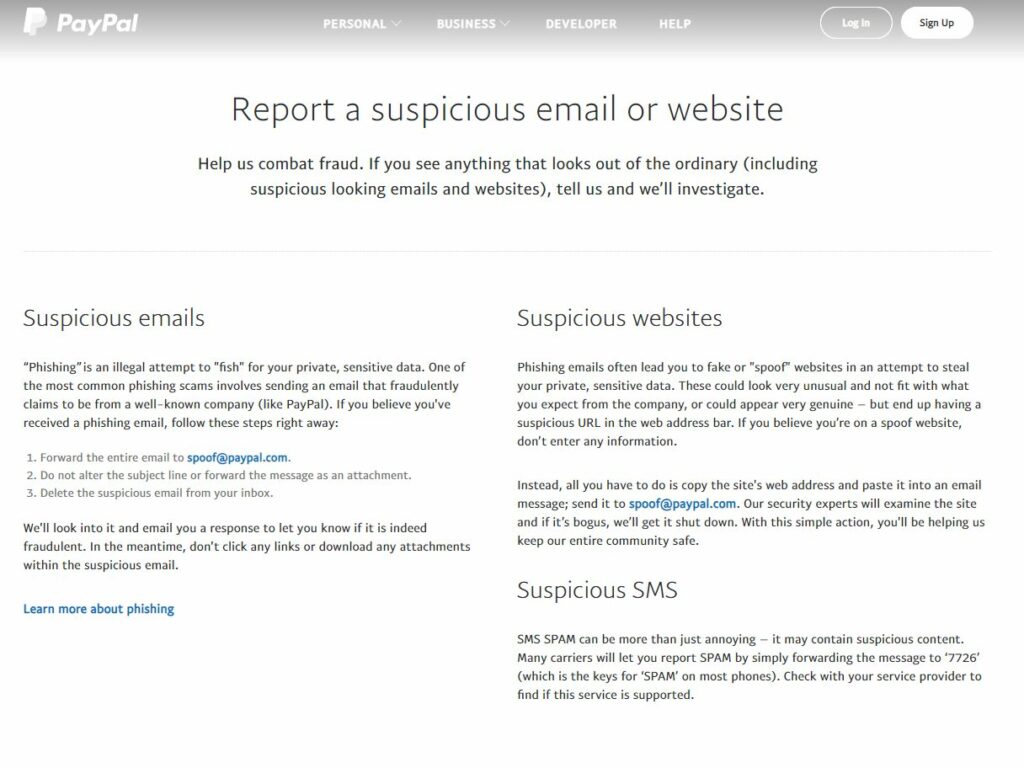Why Is My PayPal Account Suspended Again?!
It seems like it keeps happening over and over. I keep getting emails about my PayPal account getting suspended. Why oh why is my PayPal account suspended again?! The email says that suspicious activity on my account has caused PayPal to temporarily restrict the account. The suspicious activity they found has to do with credit cards linked to my acc…….wait a minute.
I don’t have credit cards linked to PayPal. What’s really going on here? Could this actually be a phishing email instead? If you believe that it is a phishing email I received and panicked over, you would be completely correct! It’s time to take another look at yet another PayPal phishing email that I received in my inbox. You can read about some others I’ve gotten in the past.
This Phishing Email Is Better Than Past Ones
There are a few things or red flags that give this email away of it being a phishing scam, but I will say that once I clicked and read the body of the email, it was much more convincing than ones of a similar nature that I’ve read in the past. This is definitely concerning because it shows that scammers are getting better or at least learning how to make their deceptive emails more convincing and that they could be an authentic email from the company they’re trying to mimic.
This is very worrying because some of the red flags I’ve said that you need to look for in the past are not actually present in this particular phishing scam. Because of this, I and others that receive these type of emails need to be as vigilante as ever because these scammers are determined to dupe as many people as they possibly can.
One great defense against this is that if you’re unable to determine whether the email is authentic, open a separate browser and then type in the website address of the actual company and then hit enter. Once the page loads, just enter your login details and then you’ll be able to truly see if your account is suspended or not.
You never ever want to click any links inside the email if you’re ever unsure the email really is from PayPal or not because those links can lead you to a fake website designed to mimic the real company and is also designed to steal as much information from you as possible, mainly your real login information.
Even if the body of the email looks very authentic and sounds convincing, there are still a few ways to tell that the email isn’t really from PayPal and I’ll start taking a look at those next.
The Email Header Still Gives It Away
One of the red flags that let me know that the email is a phishing scam is what was said in the header. The first part of the header did look fairly authentic, but the very last part of it is what ultimately gave it away. In parenthesis, it has some letters, a dash and then some numbers. It does make a little more sense compared to some others I’ve seen in the past, but the letters are Ref which I believe stand for reference. It’s supposed to be a reference number. Take a look at it:
“Your account has been suspended (Ref – 24965186878)“
I’ve seen enough of similar ones to this that let me know that the email is a phishing scam. This one is definitely better than some others though and the scammers seem to be learning about how to make more sophisticated phishing emails.

In regard to some of the others I’ve received before, some of them had much larger numbers and letters in the heading title with crazy symbols and whatnot so this one is much more convincing and a little less unusual so it is possible that the header could fool some people.
Don’t worry though, my number one red flag still works quite well here and has worked in every phishing email scam that I’ve received to date and I’ll go over that in the next part.
The Email Address
The red flag that I talk about the most and is always the most successful is looking at the email address that it came from. This should always be your go to before anything else.
An authentic email address from PayPal will have its name in the address such as @PayPal. Now this email address is a little bit tricky because it does use something that PayPal does, mainly if a transaction is done at its website in your actual account.
When you first see this in your email’s inbox, it may truly fool you into thinking its PayPal because it uses this just like PayPal does which is service@paypal.com. What you need to do when you first see that is click open the email and then immediately go to the top where it shows the email address.
Right next to service@paypal.com is another much longer email address that really doesn’t make any sense. It looks like just a lot of random numbers and letters were thrown in together to make this address. You’ll notice to, that it doesn’t even have the company’s name in the email address which makes no sense at all if its really supposed to be from PayPal (which we know it isn’t). Let’s take a look at that email address:
“email.idlewild.com@qjyqxycvvfaohkdxrvr.yoriflower.com”
See how odd and long that address is? It has just a bunch of random letters after the @ symbol and then ends in yoriflower.com. That is most definitely not a PayPal email address and thank goodness most email accounts with the different email companies out there won’t allow email addresses to be hidden.
So now you see why I came to the conclusion, without a shadow of a doubt, that this email is not from PayPal and I’m trying to be scammed and now you know what to look for as well.
It’s Important to Report Them To PayPal
It makes me very happy that PayPal and other companies have set up ways for people to let them know of phishing emails circulation around the internet and emails claiming that its from them.
PayPal has a section in their website that tells you exactly what to do if you receive a fraudulent email claiming to be from them. They want you to forward the entire email to a specific email address they have which is spoof@paypal.com.

They also have some great information on that page about suspicious websites and even suspicious texts that you might receive on your phone. What’s really nice is that PayPal has a number that you can forward those text messages too so that way they know what text messages are being sent to people on their phones.
There’s also a little bit more about what phishing is and one of the most important things that PayPal talks about is how to recognize fraudulent websites. They also provide links to wonderful resources about phishing and other fraudulent scams that are going on out there on the world wide web. Here’s a link to that page if you want to check it out yourself: PayPal’s Information Page About Phishing Scams.
Never Stop Being Suspicious of Emails
Why is my PayPal account suspended again? Well after reading all I said about this most recent email that I received and to truly tell whether an account is suspended or not, you now know that my PayPal account was not suspended at all and that this was the work of scammers trying to take advantage of me.
You should never stop being vigilante and always be on the look out for suspicious emails that you may receive in your inbox. Now that you know some of the red flags to look for in a phishing email, you can prevent yourself from becoming a victim and share with others so that they don’t fall for these scams either.
If you’ve ever fell for a phishing email before or know someone who has, feel free to post your comments below or maybe even share a particular phishing scam that you received that maybe you nearly fell for.


September 24, 2020 @ 3:48 am
Thank you so much for sharing this here. In all honesty, this security details that you have shared here can help us to avoid getting scammed in the long run by scammers who would want to phish on us and end up causing very dangerous situations and circumstances for us. Thanks you
September 24, 2020 @ 12:54 pm
Glad that you enjoyed the article. Now that you know what to look for and how to spot a phishing email, you’ll be able to protect yourself from being scammed.
September 24, 2020 @ 3:50 am
I’ve heard of a lot of PayPal accounts being suspended and it’s really getting so annoying day by day as they keep doing this. I think they are really tampering with your account, it doesn’t make any sense for them to just suspend the account for how long they want. This article is informative and I love it
September 24, 2020 @ 1:08 pm
Well remember, it’s not PayPal suspending accounts (in most cases). It’s scammers trying to make you think your account is suspended. They want you to click the link inside the email which leads to a fake PayPal website that was designed to steal your real PayPal account login information.
February 26, 2021 @ 10:49 am
Very scary of the type of scams out there
February 27, 2021 @ 2:00 pm
Yes, it is scary that these type of scams are out there. That’s why I talk about them so that people know what’s circulating and can avoid becoming a victim of these scams.
March 24, 2024 @ 11:48 am
I have been suspended on the app no idea why? Any ideas
April 22, 2024 @ 6:31 pm
Have you tried contacting PayPal themselves to see why you’re suspended and what they can do to fix it?